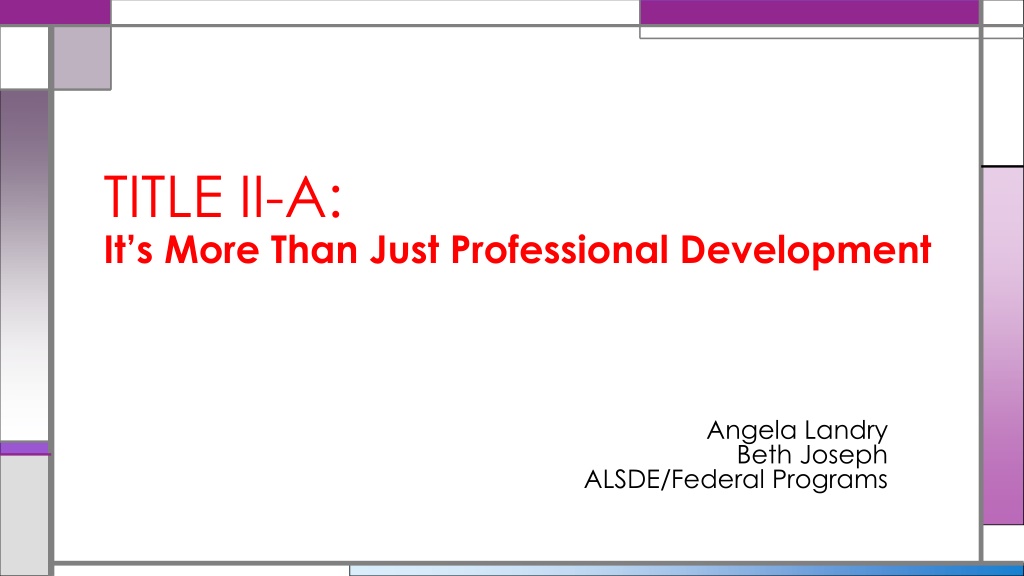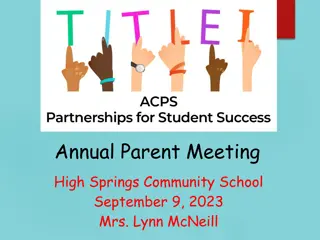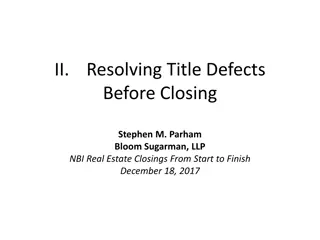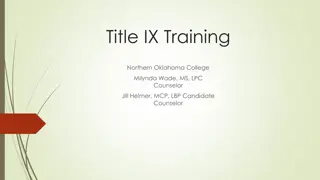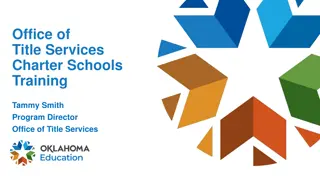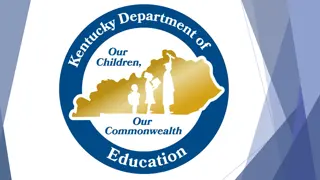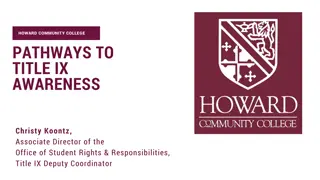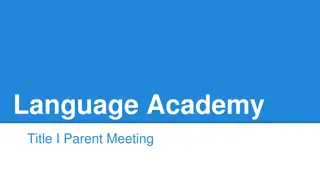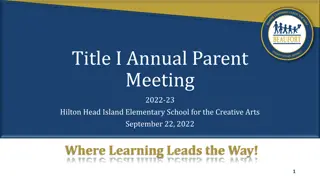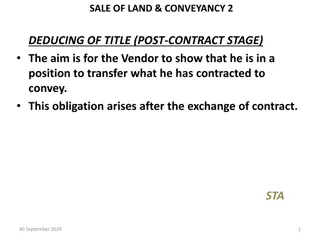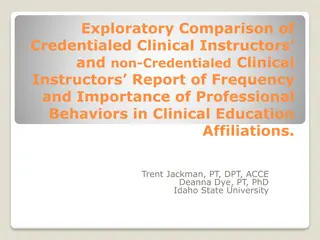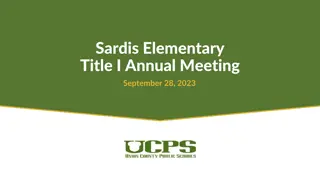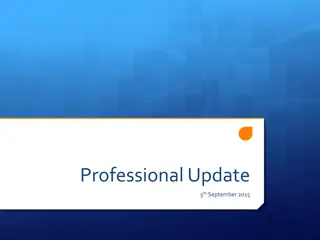Title II-A in Education: Beyond Professional Development
Title II-A in education goes beyond professional development to focus on preparing, training, and recruiting high-quality teachers, principals, and school leaders. Its purpose is to increase student achievement, enhance teacher effectiveness, and provide equitable access to quality education for all students. Local uses of Title II-A funds include evaluation systems, support for teachers and principals, and strategies to recruit and retain effective educators, especially in high-need schools.
Download Presentation

Please find below an Image/Link to download the presentation.
The content on the website is provided AS IS for your information and personal use only. It may not be sold, licensed, or shared on other websites without obtaining consent from the author. Download presentation by click this link. If you encounter any issues during the download, it is possible that the publisher has removed the file from their server.
E N D
Presentation Transcript
TITLE II-A: It s More Than Just Professional Development Angela Landry Beth Joseph ALSDE/Federal Programs
AGENDA o What is Title II-A? o Local Uses of Title II-A Funds o Professional Development o Consultation o Evaluation o Questions/Wrap-Up
What is Title II-A? Title II-A: Preparing, Training, and Recruiting High Quality Teachers, Principals, or Other School Leaders (Sec. 2001) Purpose 1) Increase student achievement consistent with the challenging State academic standards; 2) Improve the quality and effectiveness of teachers, principals, and other school leaders; 3) Increase the number of teachers, principals, and other school leaders who are effective in improving student academic achievement in schools; and 4) Provide low-income and minority students greater access to effective teachers, principals, and other school leaders
Local Uses of Title II-A Funds (Sec. 2103) Evaluation and Support Systems (Sec. 2103(b)(3)(A) LEA s may use Title II funds in developing or improving a rigorous, transparent, and fair evaluation and support system for teachers, principals, or other school leaders (1) based in part on evidence of student achievement, which may include student growth (2) include multiple measures of performance (3) provide clear, timely, and useful feedback
Local Uses of Title II-A Funds (Sec. 2103) Recruiting, Hiring, and Retaining Effective Teachers; Implementing Supports for Principals and Other School Leaders (Sec. 2103(b)(3)(B) Recruiting from Other Fields (Sec. 2103(b)(3)(C) LEAs may use Title II funds to develop and implement initiatives to recruit, hire, and retain effective teachers, particularly in low-income schools with high percentages of ineffective teachers and high percentages of students who do not meet state standards. These funds can be used to implement supports for principals and other school leaders. LEAs may use Title II funds to recruit qualified individuals from other fields to become teachers, principals, or other school leaders. Qualified individuals from other fields include mid-career professionals from other occupations, former military personnel, and recent graduates of institutions of higher education with records of academic distinction who demonstrate the potential to become effective teachers, principals or other school leaders.
Strategies for Attracting and Retaining Excellent Educators in High-Need Schools Hiring bonus to recruit teachers/administrators/school leaders in high need schools and/or high need areas such as math, science, special education, EL Retention/on-going incentives to remain in position for 2-3 years Incentives for effective/high performing teachers within your district to teach in low-performing schools Career advancement opportunities for current staff members to include paraprofessionals in gaining credentials to become certified Recruiting qualified individuals from other fields to become teachers, principals, or other school leaders Educator recruitment programs, job fairs, advertisement within the community
Strategies for Attracting and Retaining Excellent Educators in High-Need Schools Grow Your Own high school students with potential to be effective teacher Reimbursement for coursework/praxis/textbook costs to obtain a higher degree or additional certification/endorsement in high needs areas, including administration Moving supplement National Board Certified Teachers receive stipend as a retention initiative Teacher of the Year retention stipend/initiative
Local Uses of Title II-A Funds (Sec. 2103) Class Size Reduction (Sec. 2103(b)(3)(D) LEAs may use Title II funds to reduce class size to a level that is evidenced-based, to the extent the SEA (in consultation with LEAs) determines such evidence is reasonably available. LEAs may consider reducing class size as one strategy to attract and retain effective educators in high-need schools. * pay salaries/benefits for certified teachers in a particular grade or subject (Class size reduction teachers should be supplemental and not the only teacher in that grade or subject. Document the need and research-based evidence to show that the teachers are being hired to reduce the class size to address the identified need. Teachers cannot be hired with II-A funds so the district can use the funds for another purpose.)
Local Uses of Title II-A Funds (Sec. 2103) Personalized Professional Development (Sec. 2103(b)(3)(E) Title II funds can be used to provide high-quality, personalized professional development for teachers, instructional leadership teams, principals, and other school leaders. The professional development must be evidence-based and focus on improving teaching and student learning and achievement, including supporting efforts to train teachers, principals, or other school leaders to:
Local Uses of Title II-A Funds (Sec. 2103) Personalized Professional Development (Sec. 2103(b)(3)(E) 1) Effectively integrate technology into curricula and instruction 2) Use data to improve student achievement and understand how to ensure individual student privacy is protected 3) Effectively engage parents, families, and community partners, and coordinate services between school and community 4) Help all students develop the skills essential for learning readiness and academic success 5) Develop policy with school, LEA, community, or state leaders 6) Participate in opportunities for experiential learning through observation
Professional Development Sec. 8101 (42)(A)(B) Professional Development means activities that are an integral part of school and local educational agency strategies for providing educators (including teachers, principals, other school leaders, specialized instructional support personnel, paraprofessionals, and, as applicable, early childhood educators) with the knowledge and skills necessary to enable students to succeed in a well-rounded education and to meet the challenging State academic standards. Well-Rounded Education English, reading or language arts, writing Science, technology, engineering, mathematics Computer science, career and technical education Foreign languages Civics, government, economics, history, geography Arts, music Health and physical education
Professional Development Sec. 8101 (42)(A)(B) Activities that are: Sustained (not stand-alone, 1-day, or short term workshops), intensive, collaborative, job-embedded, data-driven, and classroom focused; Available to all school staff, including paraprofessionals; Inclusive of teachers of all subjects; Developed with educator input; and Regularly evaluated
Local Uses of Title II-A Funds (Sec. 2103) Personalized Professional Development (Sec. 2103(b)(3)(E) LEA Examples: Induction/Mentoring Programs for teachers/principals Mentor stipends to support new teachers Co-teaching for modeling Materials and supplies to support professional development activities Substitutes for mentors/teachers to participate Substitutes to attend Title II funded professional development Professional Development District Director/Coordinator Instructional Specialist, Reading/Math Coach, School Improvement Evidence based professional development expense (registration, transportation, lodging) Stipends for teachers, principals, or other school leaders to lead or participate in workshops/trainings (beyond contractual obligations) Periodicals, online subscriptions, and software license fees for Professional Development
Local Uses of Title II-A Funds (Sec. 2103) Increasing Teacher Effectiveness for Students with Disabilities and English Learners (Sec. 2103(b)(3)(F) Title II funds can be used to develop programs and activities that increase teachers ability to effectively teach children with disabilities and English learners, which may include the use of multi-tiered systems of support positive behavioral intervention and supports. Supporting Early Education (Sec. 2103(b)(3)(G) Title II funds can be used to provide programs and activities to increase the knowledge base of teachers, principals, or other school leaders on instruction in the early grades and on strategies to measure whether young children are progressing.
Local Uses of Title II-A Funds (Sec. 2103) Supporting Effective Use of Assessments (Sec. 2103(b)(3)(H) Use of Title II funds to provide training, technical assistance, and capacity-building to assist teachers, principals, or other school leaders with selecting and implementing formative assessments, designing classroom-based assessments, and using data from such assessments to improve instruction and student academic achievement, which may include providing additional time for teachers to review student data and respond, as appropriate.
Local Uses of Title II-A Funds (Sec. 2103) Supporting Awareness and Treatment of Trauma and Mental Illness, and School Conditions for Student Learning (Sec. 2103(b)(3)(I) Use of Title II funds to carry out in-service training for school personnel in the techniques and supports needed to help educators understand when and how to refer students affected by trauma, and children with, or at risk of, mental illness. Use of referral mechanisms that effectively link such children to appropriate treatment and intervention services in the school and in the community. Forming partnerships between school-based mental health programs and public or private mental health organizations. Addressing issues related to school conditions for student learning, such as safety, peer interaction, drug and alcohol abuse, and chronic absenteeism.
Local Uses of Title II-A Funds (Sec. 2103) Supporting Gifted and Talented Students (Sec. 2103(b)(3)(J) Title II funds can provide training to support the identification of students who are gifted and talented, including high-ability students who have not been formally identified for gifted education services, and implementing instructional practices that support the education of such students, such as early entrance to kindergarten, enrichment, acceleration, and curriculum compacting activities, and dual or concurrent enrollment programs in secondary school and postsecondary education.
Local Uses of Title II-A Funds (Sec. 2103) School Library Programs (Sec. 2103(b)(3)(K) Title II funds can support the instructional services provided by effective school library programs. Preventing and Recognizing Child Sexual Abuse (Sec. 2103(b)(3)(L) Title II funds can be used to provide training for all school personnel, including teachers, principals, other school leaders, specialized instructional support personnel, and paraprofessionals, regarding how to prevent and recognize child sexual abuse.
Local Uses of Title II-A Funds (Sec. 2103) Supporting Science, Technology, Engineering, and Mathematics (STEM) (Sec. 2103(b)(3)(M) Use of Title II funds to develop and provide professional development and other comprehensive systems of support for teachers, principals, or other school leaders to promote high-quality instruction and instructional leadership in science, technology, engineering, and mathematics subjects, including computer science.
Local Uses of Title II-A Funds (Sec. 2103) Feedback Mechanisms to Improve School Working Conditions(Sec. 2103(b)(3)(N) Use of Title II funds to develop feedback mechanisms to improve school working conditions. This can include periodically and publicly reporting feedback on educator support and working conditions. Supporting Postsecondary and Workforce Readiness (Sec. 2103(b)(3)(O) Title II funds can be utilized to provide high quality professional development for teachers, principals, or other school leaders on effective strategies to integrate rigorous academic content, career and technical education, and work-based learning, which may include providing common planning time, to help prepare students for postsecondary education and the workforce.
CONSULTATION (Sec. 2102(b)(3) LEA s shall consult with: Teachers, principals, leaders Paraprofessionals, instructional support Charter leaders, parents, community partners Others with expertise
EVALUATION OF TITLE II-A What is your program evaluation plan? Are the activities identified in the needs assessment? Are the activities aligned with challenging state standards? What are reasonable expectations of success and how can success be measured? Did teacher effectiveness increase? Did academic achievement improve? How will you use data and ongoing consultation to update and improve activities?
LEAVE A LITTLE SPARKLE WHEREVER YOU GO Angela Landry 334-694-4859 alandry@alsde.edu THANK YOU FOR ATTENDING!
